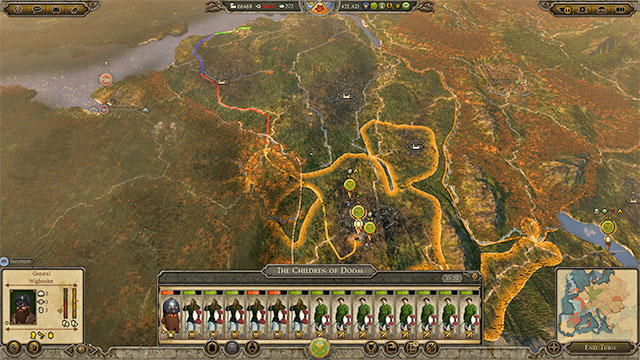Moving | War

Stances
Army should be chosen based on situation. No stance will be enough in most cases. It doesn't give any bonuses, but it does not give penalties as well. Most wars can be won with it.
Forced march allows you to travel much longer, but it tire army and doesn't allow you to initiate an attack. It can be used when traveling long distances, but when near enemy you shouldn't use it. In case of fleets this stance is called double time.
Ambush required a good territory, like mountain paths. It has a risk of failure and makes army unable to move. But if it success, it allows to attack surprised enemy. A stance that can be used in specific situations, but it can be useful.
Raiding tire and slow down army, but in return it spread chaos in province troops walk through. A good stance for breaking relations with other factions and for earning money on enemy settlements and trading routes without destroying them. It allows to speed up a rebellion in restless provinces by lowering order. It isn't effective during a war campaign as it weakens army that uses it. Fleet has such stance as well.
Fortify is a stance used in defense situations. Very effective when blocking narrow, mountain passages or routes, forcing enemy to fight a well prepared adversary or move around him. With the right placement, a fortified army can greatly limit enemy possibilities. In case of fleet a similar role has the patrol stance.
Difficult territory
If you want your army to reach destination in one piece, you must avoid swamps and marching during winter. Swamps kill part of your soldiers in each formation, no matter if army stops or just walk through them. Lots of swamps can be found on routes around roads and in some cases using them might be the right choice, like for avoiding enemy army, but usually it is better to use roads.
Marching during winter is harmful only if army is stationed outside a city. Each army that at the end of turn is in a city will survive, and even replenish losses. Some traditions allow army to march during winter.
Zone of Control
Every army, settlement and fleet has one. A zone makes it impossible to get close without attacking. In practice it forces army that doesn't want to attack a settlement or another army to walk around them, even if it makes the road much longer. Thanks to that, a single strong army that blocks a mountain passage, like in Alps, is able to force enemy forces to look for other road.
Zones of few armies can get one on another, they can even combine. It means that you can position two armies next to each other and by doing so increase the zone unavailable for enemy armies. At the same time enemy might be less interested in attacking as armies standing next to each other can backup each other in battle You just need to add stance: fortify to it and a powerful barrier against enemy invasions will be created, especially useful in territories full of mountains or rivers.
Replenishment of losses
From spring to autumn an army replenish its losses automatically while remaining on allied province territory. It affects both provinces that belongs to you and to factions with which a military alliance has been signed. A formation gains at least few men each turn, which that completely regaining strength of a decimated formation can take even two years (eight turns). During winter formation is replenished only on settlement territory. Outside it loses units.
How much units you gain is based on replenishment variable. It can be changed with army stances, offices and random events. If replenishment level is below zero, for example due to disease or lack of food, the number of soldiers in a formation will start dropping. Increase of soldier numbers can be recognized by green crosses, and the decrease by skulls shown under their illustration.
Units are replenished faster in regions where they can be recruited. It works the same with ships, that instead of staying on sea have been moved to ports. It is important since a fleet on the sea replenishes its rank very slowly, much slower than land formations. Complete regain of strength can take them even few years. Move cursor on the sea and an information will appear containing replenishment speed on the sea and in nearby ports.
Transport fleet
There are no transport fleets in Attila. Move your army on the sea and it will be automatically changed into transport fleet. Army can return to land after finding a beach. Transition between land and sea uses lots of army movement points. Because of that it is better to use bridges, that makes traveling through sees and large rivers much easier.
Sea sickness
This penalty occurs at land armies that stay for too long on sea. If they are attacked during a sea travel, their statistics in battle will be lower. Sickness ends immediately after returning to land. Because of that, any army that moves through sea should be always accompanied by a fleet.
You are not permitted to copy any image, text or info from this page. This site is not associated with and/or endorsed by the SEGA or Creative Assembly. All logos and images are copyrighted by their respective owners.
Copyright © 2000 - 2025 Webedia Polska SA for gamepressure.com, unofficial game guides, walkthroughs, secrets, game tips, maps & strategies for top games.
